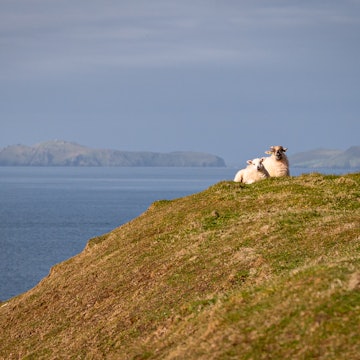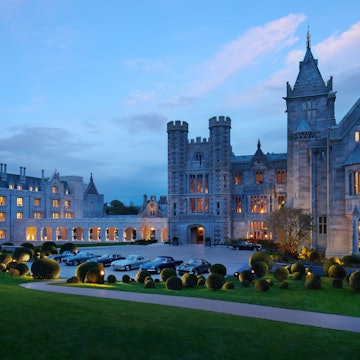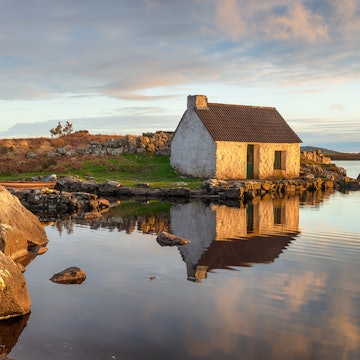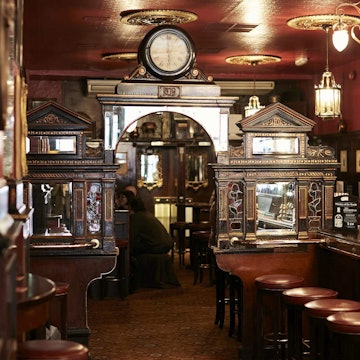

Take time to explore beyond Dublin's city center with these top day trips. Marco Bottigelli / Getty Images
The richly layered city of Dublin – full of culture, community spirit and character – has plenty of things to keep you busy and entertained, with even more beyond the capital that's worth seeing on a day out.
Within a 40km (25-mile) radius of Dublin's center you can travel back in time to the neolithic era, visit grand Georgian estates and explore one of the most beautiful valleys in the country, at the foot of which are nestled the ruins of a 6th century monastic settlement. A little closer to the city are some seaside suburbs, including one that is a popular weekend destination for Dubliners looking for a scenic walk and some of the best seafood around.
Here's our guide to the best day trips from Dublin.

1. Get the DART to the seaside village of Howth
Travel time: around 45 minutes
Tidily positioned at the foot of a bulbous peninsula, the pretty port village of Howth (the name rhymes with "both") is a major fishing center, a yachting harbor and one of the most sought-after addresses in town.
It's an easy hop out of the city – the DART drops you right by the harbor, where you can take a stroll among the fishing boats or pop into Howth Market for a coffee and a snack. But the real appeal comes a little further afield. Walk about 10 minutes along the coast and you'll be at the start of the Howth Cliff Path Walk, a 6km (3.7-mile) loop that takes you over the headland for gorgeous views of the grassy slopes that run down to the sea. If you want to do a proper hike, there are longer routes that lead to the Baily Lighthouse and back over rough, mountainous terrain.
And when you’re done, there are great restaurants where you can try some of the freshest seafood you’ll find anywhere in the city, including Octopussy’s for seafood tapas, Aqua for more elegant fare and, if you like your seafood served deconstructed, the superb Mamó, a modern bistro with an excellent value set lunch.
How to get to Howth from Dublin: Howth is at the northern end of the DART line.
Fancy seeing more of Ireland on foot? Here's our guide to the country's best hiking routes

2. Visit the neolithic passage tombs of Brú na Bóinne
Travel time: 1½ to 2 hours
The vast neolithic necropolis known as Brú na Bóinne (the Boyne Palace) is one of the most extraordinary sites in Europe. A thousand years older than England's Stonehenge, the tombs, burial mounds and passages here are a powerful testament to the mind-boggling achievements of prehistoric humankind.
All visits begin at the superb visitor center, where you can learn the history of the site as well as get a fascinating insight into the times, complete with a little digital razzmatazz. There’s also a reconstruction of Newgrange’s interior passage.
From here, shuttle buses take you to the passage tombs: the most popular tour takes in Knowth and Newgrange. You can’t go into Knowth, but the tour covers the collection of megalithic art carved into the exterior slabs of stone: keep an eye out for the depictions of the lunar cycle.
The star of the show is Newgrange, one of the most remarkable prehistoric sites in Europe. The white quartz walls of the mound are impressive, but that pales in comparison to when you set foot into the passage and make your way to the center. Once there, the guide turns off the lights and a thin shaft of amber light starts to make its way down the tunnel – a simulation of the actual winter solstice ceremony, when on December 21 the whole passageway is illuminated by sunlight piercing its way through the roofbox above the main entrance. Even the simulation is a mystical experience.
How to get to Brú na Bóinne from Dublin: If you’re driving, Brú na Bóinne is 50km (31 miles) north of Dublin; take exit 9 off the M1 and follow the signs. The easiest way to get there by public transport is to get the train or bus to Drogheda and then hop on the Local Link 163 (40 minutes; three times daily) which goes from the train station and the Spar opposite the bus station. Alternatively, you can get there by organized tour from Dublin; one of the better options is Mary Gibbons Tours (€75), which operates full-day tours with plenty of historical knowledge.

3. Walk around the monastic ruins of the beautiful Glendalough
Travel time: around 1 hour
It’s only about an hour south of the city, but Glendalough feels like a place lost in time. This gorgeous valley (the name Glendalough comes from the Irish, Gleann dá Loch, meaning "Valley of the Two Lakes") is one of the most beautiful corners of the whole country and the epitome of the kind of rugged, romantic Ireland that probably drew you to the island in the first place.
At the heart of it are the ruins of a monastic settlement established by St Kevin around 498 CE. These include a 1000-year-old round tower, a ruined cathedral and the tiny church known as St Kevin's Kitchen.
The substantial remains of this important monastic settlement are certainly impressive, but an added draw is the splendid setting: two dark and mysterious lakes tucked into a long, glacial valley fringed in forest that have some great walking trails and a couple of hikes up the surrounding mountains. It is, despite its immense popularity, a deeply tranquil and spiritual place, and you will have little difficulty in understanding why those solitude-seeking monks came here in the first place.
If you've got your own car, one of the most scenic drives in Ireland is along the Military Rd between Laragh (1.5km/0.9 miles from the car park at Glendalough) and Glencree, on the road to Enniskerry. The road, so-named because it was built in the early 19th century by the British Army, traverses the beautiful Glenmacnass Valley (and a fabulous waterfall) and the Sally Gap, where a slight detour will bring you to a gorgeous viewpoint overlooking Lough Tay. Another detour by the Glenmacnass Waterfall car park takes you to a scenic spot over heart-shaped Lough Ouler.
How to get to Glendalough from Dublin: Glendalough is tucked into the Wicklow Mountains 68km (42 miles) south of the city center. To get there by car, follow the N11 south and take the R755 at Kilmacanogue; the narrow road winds its way through the mountain. A popular alternative is to take the bus: St Kevins Bus departs from the bus stop on St Stephen's Green North in Dublin at 11:30am, with the latest return bus leaving Glendalough at 4:30pm.
Exploring Ireland by road? Here are the country's best driving routes

4. Pore over the grandeur of the Powerscourt Estate
Travel time: 45 minutes to 1 hour
Wandering through the exquisite formal gardens of the 64-sq-km (25-sq-mile) Powerscourt Estate should give you an idea of how extravagantly the 18th-century artistocracy lived – and the stunning views of the surrounding countryside they enjoyed. At the heart of Wicklow’s most visited attraction is a beautiful Palladian mansion, which was designed by Georgian architect Richard Castle between 1730 and 1741.
Most of the 68-bedroom house is not open to the public, but there's a fine cafe and several gift and homewares shops, while the grounds are home to two golf courses, a garden center and the best hotel in Wicklow. If you’re driving (or part of a tour), about 6km (3.7-miles) south of the house brings you to Powerscourt Waterfall, the tallest in Ireland and a popular picturesque spot that is best enjoyed after heavy rainfall.
When you’re done in the estate, a short walk down the hill brings you to the village of Enniskerry, which was established for the estate workers but is now a nice spot for a bit of lunch.
How to get to Powerscourt Estate from Dublin: Powerscourt is off the M11/N11, 27km (17 miles) south of the city center. Get off the N11 at Exit 7 and loop around, rejoining the N11 going northward and take the first exit toward Enniskerry Village.
Dublin Bus No 44 and Local Link 144 go from the city center to Enniskerry village taking between 45 minutes and 1 hour). From here, the walk to the house should take about 20 minutes (the main entrance to the estate is 0.5km/0.3 miles up the hill from the village). You can also get the 185 bus in Bray, which is on the DART train line.
















